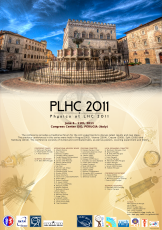Raphael Granier De Cassagnac
(Ecole polytechnique, CNRS-IN2P3)
07/06/2011, 14:30
We present early results of the CMS experiment from PbPb collisions at $srqrt{s_{NN}}$ = 2.76 TeV, probing quark and gluon matter at unprecedented values of energy density. The capabilities of the CMS apparatus allows us to investigate various hard probes, as well as bulk particle production and collective phenomena, using the calorimetry, muon and tracking systems covering a large range in...
Nicolas Borghini
(Univ. of Bielefeld)
07/06/2011, 14:50
The extended kinematical reach in the collisions of heavy ions at the LHC opens several possibilities: new phenomena might emerge, while "known" observables are cast under a new light. I shall present a few examples of such effects, as well as tentative conclusions that could be drawn from the 2010 Pb+Pb run.
Michal Broz
(Comenius University-Slovakia)
07/06/2011, 15:15
The Large Hadron Collider (LHC) provided the first p+p
collisions in the period of November-December 2009. Since then,
a large data sample has been recorded by all LHC experiments.
This event sample allows us to study more and more exotic particles and events. The ALICE (A Large Ion Collider Experiment) experiment, though designed primarily to study heavy ion collisions, has a rich...
Tomasz Bold
(UC Irvine, AGH-UST Krakow)
07/06/2011, 15:35
A broad program of measurements using heavy ion collisions is underway in ATLAS, with the aim of studying the properties of QCD matter at high temperatures and densities. With the factor of 14 increase in collision energy compared to RHIC data, significant insight has already been gained using dijet asymmetry measurements, but a more detailed study of both high pT probes and global features...
